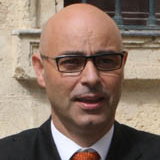Symmetry Breaking in Quantum Phenomena
A special issue of Symmetry (ISSN 2073-8994). This special issue belongs to the section "Physics".
Deadline for manuscript submissions: closed (30 September 2018) | Viewed by 7233
Special Issue Editors
Interests: mathematical modelling of quantum phenomena; supersymmetric quantum mechanics; mathematical modelling of topological materials; supersymmetric and superintegrable dynamical systems; soliton and kink solutions of nonlinear partial differential equations; phase space quantum mechanics, Wigner functions and applications; symmetries of physical systems in spaces of constant curvature; position-dependent mass problems in quantum mechanics; symmetries of finite difference equations
2. Facultad de Educación de Palencia, Campus La Yutera, Universidad de Valladolid, Avd. Madrid, 44, 34004 Palencia, Spain
Interests: quantum field theory; vacuum phenomena; quantum optics; cosmic strings
Special Issue Information
Dear Colleagues,
The break of symmetries in physical systems, either in or out of equilibrium, gives rise to a number of phenomena, which allow to probe topological and symmetric properties of the states of the systems, as well as of their underlying field theory. In the case of discrete symmetries, for instance, the presence of a magnetic field breaks the time-reversal symmetry in free space, and the electromagnetic vacuum is said to present magnetic birefringence; likewise, time-reversal violation modifies the Casimir interaction between non-reciprocal media; in magneto-chiral media, it is the simultaneous violation of parity and time reversal that gives rise to a vacuum momentum; and the break of parity in an asymmetrically excited system is at the origin of the apparent violation of the action-reaction principle. In addition, spontaneous symmetry breaking in field theories which undergo either thermal or quantum phase transitions leads to the formation of topological defects such as cosmic strings, domain walls, monopoles, vortices, etc. By studying the properties of the resultant network of topological defects, valuable information about the parameters and the symmetry of the underlying field theory can be extracted.
It is the aim of this Special Issue to gather works on these topics, which provide a representative overview, as well as to stimulate progress in their investigation.
Prof. Luis Miguel Nieto
Dr. Manuel Donaire
Guest Editors
Manuscript Submission Information
Manuscripts should be submitted online at www.mdpi.com by registering and logging in to this website. Once you are registered, click here to go to the submission form. Manuscripts can be submitted until the deadline. All submissions that pass pre-check are peer-reviewed. Accepted papers will be published continuously in the journal (as soon as accepted) and will be listed together on the special issue website. Research articles, review articles as well as short communications are invited. For planned papers, a title and short abstract (about 100 words) can be sent to the Editorial Office for announcement on this website.
Submitted manuscripts should not have been published previously, nor be under consideration for publication elsewhere (except conference proceedings papers). All manuscripts are thoroughly refereed through a single-blind peer-review process. A guide for authors and other relevant information for submission of manuscripts is available on the Instructions for Authors page. Symmetry is an international peer-reviewed open access monthly journal published by MDPI.
Please visit the Instructions for Authors page before submitting a manuscript. The Article Processing Charge (APC) for publication in this open access journal is 2400 CHF (Swiss Francs). Submitted papers should be well formatted and use good English. Authors may use MDPI's English editing service prior to publication or during author revisions.
Keywords
- Parity violation
- Time reversal violation
- Vacuum birefringence
- Casimir momentum
- Non-reciprocal media
- Directional spontaneous emission
- Spontaneous symmetry breaking
- Topological defects formation: cosmic strings, domain walls, monopoles, vortices, disclination lines
- Kibble-Zurek mechanism
- Supersymmetry breaking
- Beta decay






